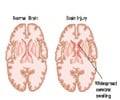The way in which a normal protein can be converted into a prion, an infectious agent that causes fatal brain diseases in humans and mammals has been determined by scientists.
The way in which a normal protein can be converted into a prion, an infectious agent that causes fatal brain diseases in humans and mammals has been determined by scientists.
The finding, in mice, is expected to advance the understanding of transmissible spongiform encephalopathies, or TSEs, a family of neurodegenerative diseases that include Creutzfeldt-Jakob Disease, kuru and fatal familial insomnia in humans, scrapie in sheep, and bovine spongiform encephalopathy in cattle, also known as "mad cow disease.""This study provides the strongest evidence yet to prove the prion hypothesis," said Jiyan Ma, associate professor of molecular and cellular biochemistry at Ohio State University and senior author of the study. "It also offers important insights into the molecular mechanism and potential therapeutic targets for these diseases."
The study is in press in the journal Science and appears online as a Science Express report on Jan. 28, 2010.
In 1982, the concept of a prion was introduced as an improperly folded protein that is able to recruit other normal proteins to take on those same characteristics, leading to widespread damage in the brain. However, lingering doubt remained among some investigators that a protein - instead of pathogens like viruses - is actually the infectious agent for these brain diseases.
The skepticism related to unsatisfactory results of creating an infectious prion with recombinant prion protein, a protein created artificially in bacterial cells, which many consider the "holy grail" of the prion field. With this work, Ma and his colleagues were successful in using recombinant protein to generate a prion.
Using a recombinant mouse prion protein, known as PrP, the team discovered that the protein''s interaction with lipids, the main structural component of a cell membrane, leads to its change in conformation, or misfolding of the protein.
Advertisement
"The major thing we showed in this study is that the infectious agent in these diseases is truly a misfolded protein. We folded recombinant mouse prion protein into its normal shape, then converted it into a different conformation and showed that when it infected an animal, it caused full-blown prion disease, with all of the characteristics," Ma said.
Advertisement
After creating the recombinant prion protein in bacterial cells, the team tested various conditions mimicking the protein''s interactions with lipids, introducing additional compounds that Ma called "helper molecules" that could promote the conversion.
After many attempts, they found the condition that was able to convert normal recombinant prion protein into an infectious prion, which requires the presence of lipids and polyanions. They determined that the converted protein was a prion based on three characteristics: The misfolded prion protein molecules clumped together, resisted the effects of an enzyme that processes normal prion protein, and recruited surrounding normal proteins to misfold along with them.
To demonstrate that it was able to cause disease in an animal, the team injected the recombinant prion into the brains of a group of normal mice. These mice showed a host of symptoms of TSEs 130 days after the injection, including clasping of their limbs, rigid tails and severe weight loss. Most survived only 20 days after symptoms appeared.
The brains of these mice had classic signs of prion disease, including microscopic holes, called spongiosis, throughout the brain.
Three control samples were used for comparison, and did not produce any clinical symptoms or structural brain changes in mice.
Brain tissues from diseased mice were then injected into the brains of a group of additional mice to test for transmission of the illness. These mice also developed prion disease.
This finding should significantly advance prion research, Ma said.
"For example, we still don''t know what actually makes prions infectious or how their propagation causes damage in the brain," he said. "We can use this in-vitro system to apply to studies of why it is infectious. We can also use it to develop methods to stop that infectivity or disrupt the infectious conformation. This information can be potentially developed as therapeutic strategies against these fatal diseases."
This work was supported by the Ellison Medical Foundation, the National Institutes of Health and East China Normal University (ECNU).
Co-authors of the work are Fei Wang and Xinhe Wang of Ohio State''s Department of Molecular and Cellular Biochemistry, and Chong-Gang Yuan of the ECNU School of Life Science.
Source-Newswise
RAS











